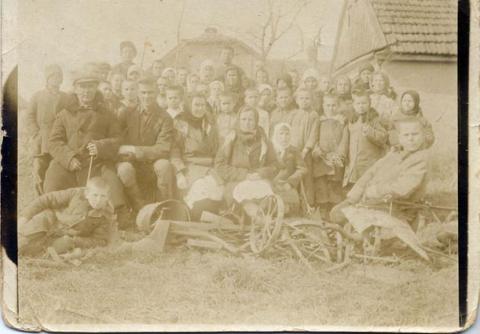
Aims and objectives
In the spring of 1941, around 825,000 Jews lived in thousands of cities, townships and villages in Hungary. Four years later the majority of the Jewish congregations no longer existed. The traumatic change can be illustrated by the drastic drop in their numbers: two-thirds of the 709 congregations in Trianon ("Smaller") Hungary disappeared without a trace. The destruction was indicated by the perishing of the community infrastructure. Hundreds of synagogues and prayer houses were demolished, and only 14 operating temples were left. Congregational archives shared the same fate: most of them were destroyed, looted and scattered during and after the Holocaust. Archives and libraries of many Jewish associations and communities being terminated had to be transferred to the pseudo-scientific Hungarian Institute for the Research of the Jewish Question set up by the government collaborating with the Nazis. Several other collections were abandoned and doomed to perish. An example is that of the Balassagyarmat orthodox community that was dumped on an empty lot in 1944 by the local authorities and left there exposed to the elements. If the archives are the collective memory of a community, then the Hungarian Jews were not only looted, disenfranchised and murdered in large numbers, but the survivors were deprived of their collective memory too, during and after the Holocaust.
After the war, some of the congregations were reorganised but only with a fraction of their original population. They also tried to recover their archives or recreate it based on bodies of documents surviving the Holocaust. Many revived congregations soon closed down because of migration and emigration.
Today there are only 30 Jewish congregations in the country. Only around 20 possess documents created before 1990. The largest, still existing body of Jewish community documents is stored, organised, inventoried and handled by the Hungarian Jewish Archives in Budapest. However, the archives of the countryside congregations are not stored under proper archival circumstances, since the communities struggle with a lack of funding and personnel. There are no inventories or finding aids describing the contents of these materials. In several places (e.g., Pécs and Szeged) the documents are poured into unsuitable storage areas, where the materials are decaying. Moreover, there are locations where there is no organised community, and the documents are kept by only a few, usually elderly, individuals. For example, in Gyöngyös, an elderly gentleman, the last observant Jew of a once vibrant community, held the key to an old prayer house where community records dating back to the late 1800s were held.
In Budapest there are also scattered archival collections outside the Hungarian Jewish Archives’ institutional reach, such as the completely unorganised repository of the small Orthodox community in Pest.
According to the scarce information that is held, the archives are likely to contain the following types of documents: documents related to the institutional operations of the congregations; Holocaust-related documents; burial records; birth registries; death registries; registries of marriages.
The date range of the collection is wide. The earliest papers date back to the late 18th century, while parts of the collections probably were created in the late 1900s.
The main objectives of the pilot project are:
- to explore all existing Jewish congregational archives in the Hungarian countryside and in certain Budapest locations, and other repositories holding Jewish community documents;
- to survey the material contained by these archives;
- to create a general description for the collections;
- to make sample copies from various bodies of documents;
- to transfer some of the materials to the Hungarian Jewish Archives in Budapest if necessary and feasible;
- to prepare a major research project to copy most of the collections.
The pilot project will have the following results:
- the remaining Jewish community documents will be surveyed and inventoried;
- a central registry of such documents will be created;
- a general description of the collection will be authored.
It is hoped the pilot project may foster the preservation of documents of great significance regarding the history and culture of the Jews in Hungary.
Outcomes
The project successfully surveyed the archives of the following Jewish congregations: Baja, Gyöngyös, Balassagyarmat, Miskolc, Nagykanizsa, Székesfehérvár, Szombathely, Veszprém, Debrecen, Pécs, Pápa, Győr, Kaposvár, Sopron, Komárom-Komárno, Zalaegerszeg, Szolnok, Szeged, Nagykőrös and the Budapest Orthodox Congregation. Detailed information was also obtained on the material of the Kecskemét Jewish community. General descriptions of the collections were created, detailed lists of parts of the bodies of documents made, and sample photographs taken.
As a result of the survey, it has been established that there are approximately 90-100 linear metres of documents (volumes and unbound materials) scattered in more than twenty congregational archives nationwide. Although in some locations the storage conditions are satisfactory, such as in Szeged, Pécs and Veszprém, in many places the documents are kept in unsuitable conditions. The timeframe of the collections is typically in the range of 1850-1970. The content is varied, but the main elements reflect the congregational, communal nature of the collection. The common elements are: birth, marriage and death registries; minutes of meetings of various community bodies; financial, cash and tax registry books; lists of community members; Holocaust-related materials; and registered documents of the community’s administration.
The surveyed documents represent invaluable pieces of Jewish heritage in Hungary. A large part of the collections is undoubtedly endangered due to frequently unsatisfactory storage conditions, and the fact that some of the congregations are maintained by elderly people, whose respectable, selfless and irreplaceable work will be impossible to sustain in the long run. By surveying these archives, the first steps were able to be taken towards saving these significant collections.




